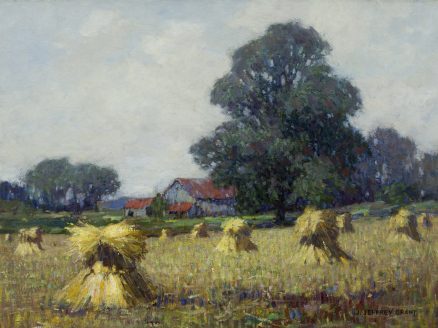Untitled (Harvest Time, Barney’s Orchard)
, circa 1920sOil on canvas, 18⅛ by 24⅛ inches
- Categories
- Immigrant artists
- Landscapes
- Zoom in on Artwork
- Print Page
- Email Page to Friend
Jeffrey Grant’s bucolic late-summer harvest scene presents a field of golden grain with distant trees sheltering a cluster of farm buildings, all silhouetted against a tranquil sky. Grant emphasizes the season’s fulfillment by depicting the fleeting moment between the labor of harvest and the waning of ripe summer. The seemingly straightforward representation is carefully composed, with the bulk of the nearest haystack, at lower left, balanced with the large tree just to the right of center. There, red-and-white structures form the composition’s focal point, setting off nature’s green and gold tones.
Such images of local agrarian bounty won considerable favor with Chicago’s largely conservative art public in the early twentieth century. As modernist art challenged artistic convention, particularly in the wake of the Armory Show of 1913, aesthetically pleasing and morally uplifting representations of the rural landscape became vehicles for embattled standards of art. A number of Chicago landscape artists painted fields dotted with grain stacks—emblems of the rewards of productive work as well as regional identity. The subject also recalled the famous serial haystack paintings of French Impressionist pioneer Claude Monet, whose works were much prized by Chicago collectors; in 1922 Monet’s Stacks of Wheat (Sunset, Snow Effect) (1890/1891) was donated to the Art Institute of Chicago with the Potter Palmer collection of paintings.
The origin of Grant’s title is unknown and no orchard is visible in the image, but the setting probably is rural Illinois. In 1938 the artist exhibited a work titled Harvest Time at the Palette and Chisel Club, and in 1944 some of his “Illinois farm country paintings” were included in a two-person exhibition he shared with Charles Biesel at the Art Institute.i By the 1930s Grant favored nearly square formats, high horizons, and decorative patterned brushwork that flattens forms for a subtly abstract effect. Harvest Time, Barney’s Orchard, in contrast, appears to date to an earlier period, likely the early 1920s. The somewhat stylized treatment of the trees, blurred outlines of forms against the sky, and interweaving of distinct strokes of bright color in the stubbly foreground are consistent with the modified impressionism that developed among Chicago’s conservative landscape painters during in the 1910s.
Wendy Greenhouse, PhD
Donated by M. Christine Schwartz to the Newberry Library, Chicago, Illinois, in 2021
i “Exhibit of 2 Chicagoans’ Paintings Opens Thursday,” Chicago Tribune, July 25, 1944.
